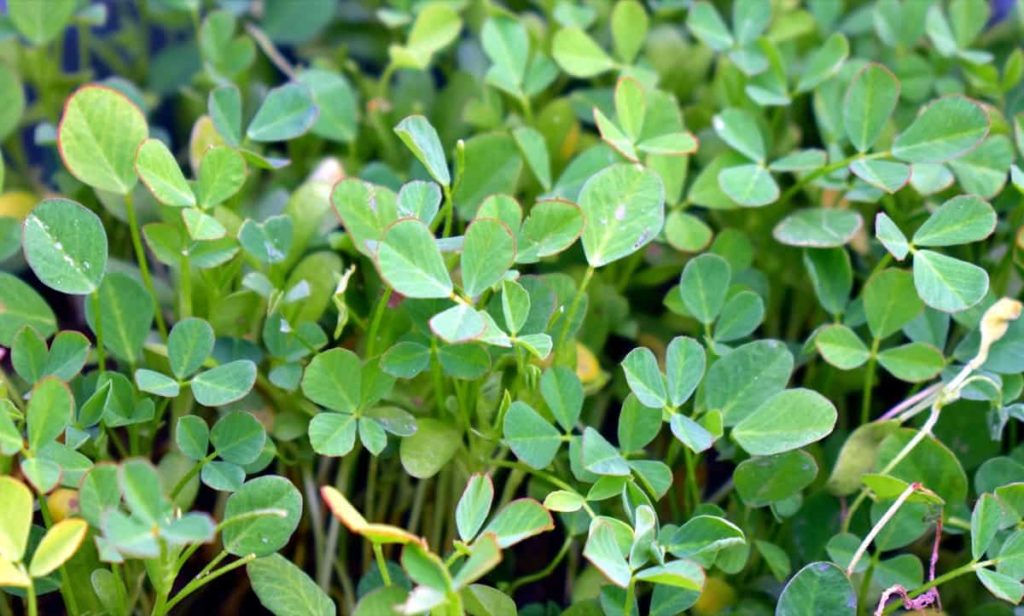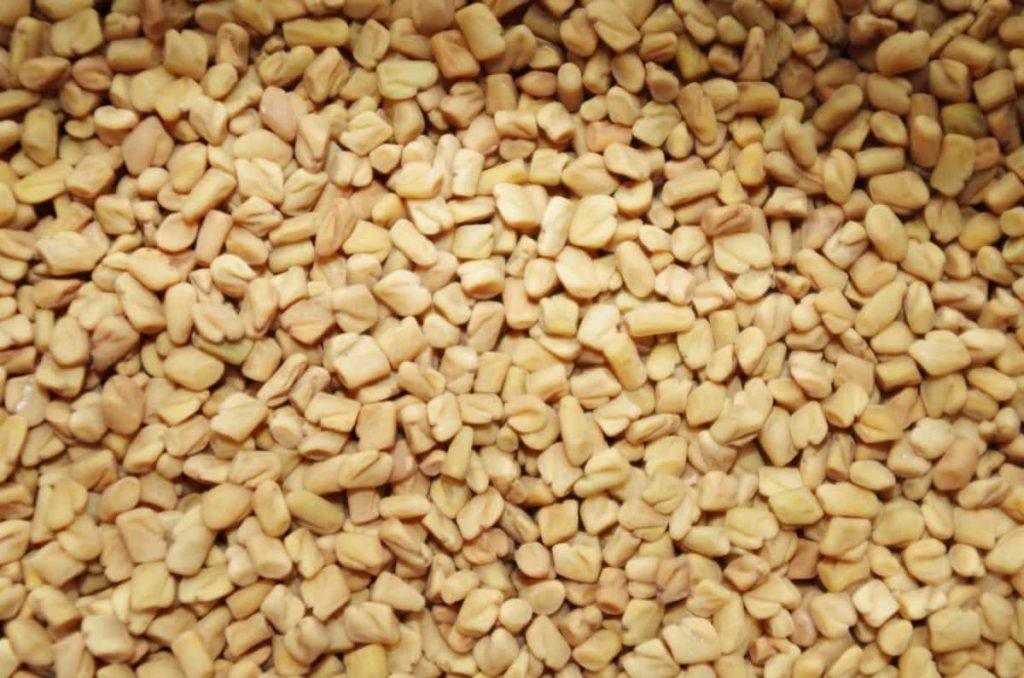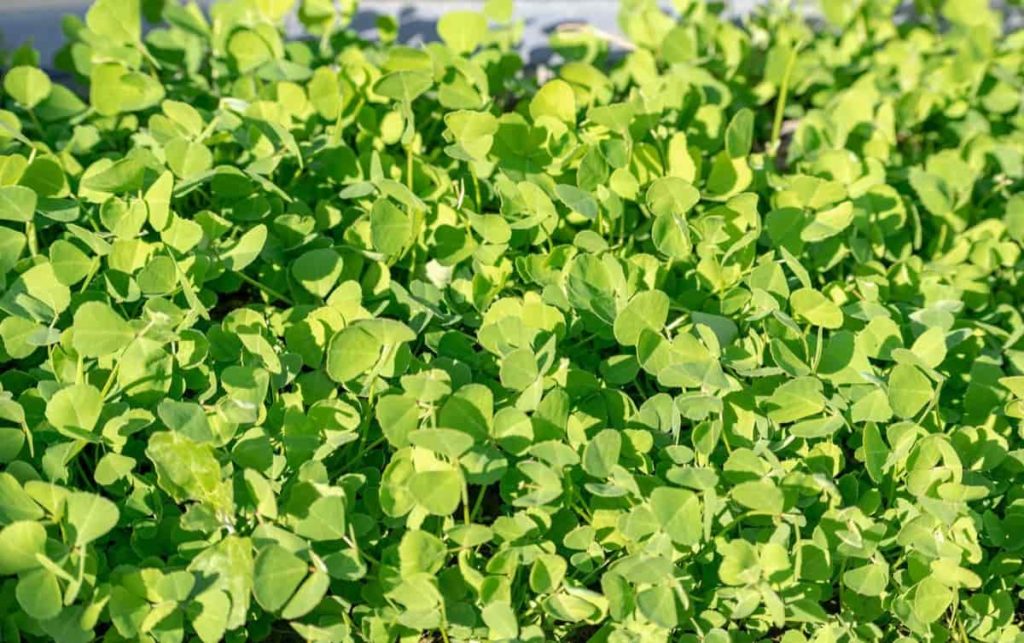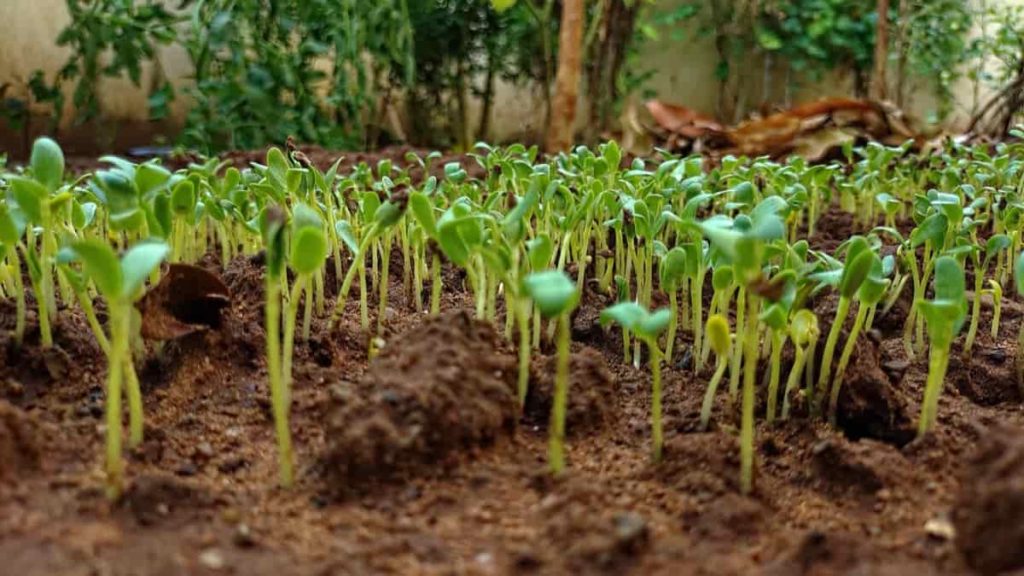Fenugreek herbs are not difficult to grow, and the plant, which produces white or purple flowers that turn into interesting yellow pods, is an attractive addition to the garden. Fenugreek leaves are present in dishes worldwide, from curry to salads. While both seeds and leaves are edible, their physical characteristics differ. Although seeds are the most well-known and commonly used part of the plant, fresh Fenugreek leaves can add flavor to salads. If you give all the Fenugreek’s needs, you will be rewarded with a bountiful harvest within a few days.

How to grow Fenugreek/Methi from seed to harvest
How long does it take for Fenugreek to harvest?
- You can easily grow Fenugreek from seed. You can also use seeds from a grocery store meant to be used as food. The leaves of the small seed variety are slightly smaller, have yellow flowers, and will grow again after cutting. Fenugreek does not like transplantation, so it should be sown directly in a well-drained sunny place.
- You can harvest microgreen Fenugreek within 8 to 10 days of sowing. As a regular vegetable, Fenugreek greens can be harvested in 3 to 4 weeks when the leaves mature. Harvesting is done by uprooting entire plants and cutting long roots.
- Fresh leaves are ready for harvesting in 30 to 40 days once the plants are 10 inches long. Try to use Fenugreek as a cut-and-come-again crop by cutting up to 4 inches above the soil. If growing for seeds, allow the plants to mature through the flowering and pod stages fully.
- The leaves of Fenugreek plants will be ready for harvesting within 30 to 40 days of sowing. Carefully cut the upper third of the mature stems so that the rest continue to grow. This will encourage branches to facilitate later flowering and seed production.
How many times can you harvest Fenugreek?
- Fenugreek leaves are ready for their first crop about 20 to 30 days from the plantation day. You should gently trim the leaves and use them for various culinary purposes. Make sure to cut the leaves so that you leave the twigs attached, as they will grow again in the next 15 days.
- It will also encourage branches which will later increase the production of flowers and seeds. After cutting, the leaves will grow again in about 15 days. You can continue harvesting the leaves multiple times until the plant starts to flower.
- Pick Fenugreek leaves over the plants whenever you need them. Regular selection will encourage the growth of new leaves, harvesting fresh leaves every two weeks.
How do you harvest Fenugreek seeds?
- Until the plant starts to flower, you can harvest the leaves. There will be a little more patience in harvesting seeds. You will be able to collect Fenugreek seeds (Fenugreek) after 3 to 5 months of the plantation. It will prepare the seeds between small pods; each pod will have about 15 to 17 seeds.
- For seeds, wait for the pods to turn yellow, indicating that they are fully ripe, and harvest the seeds before the pod opens.
In case you missed it: How to Grow Spices in Pots at Home: Garlic, Ginger, Fenugreek, Turmeric, Clove, Cumin, and Cardamom

Can I grow Fenugreek indoors?
- It is the easiest leafy vegetable to grow at home compared to other vegetables. However, you need water to grow Fenugreek seeds and potting mixes/fertile soils.
- If you’re cultivating it for use as a vegetable or herb, you can plant it any time between spring and mid-autumn. If you live in any hot place with frost-free winters outside, you can grow them throughout the year. Similarly, you can grow this vegetable in a bright window indoors throughout the year.
- You can grow this indoors and outdoors, so choose a place where it can get 4 to 5 hours of sunlight daily. After 20 days of the plantation, Fenugreek plants are ready for the first crop, cut leaves, and used to prepare delicious recipes.
- This herb can be easily grown in containers. Place seeds in pots indoors on sunny windows, or place pots on the balcony or patio garden. Fenugreek is a shallow-rooted plant, so you don’t need a deep container.
- You can plant Fenugreek seeds in a pot indoors on sunny windows or place the pot on the balcony or a patio garden. Use a wide planter 6 to 8 inches deep with good drainage. Then fill the container with a 2/3 potting mix and 1/3 compost. Use a wide planter about 6 to 8 inches deep with good drainage.
Should I soak Fenugreek seeds before planting?
- You should soak the seeds overnight before planting to fasten the seed germination and increase germination’s success rate. Fill a bowl/glass at a warm temperature, soak the seeds, and leave them there overnight. Take out water before planting seeds in the morning.
- To grow Fenugreek, you should start by soaking the seeds in a bowl of room temperature water overnight to increase their germination rate. The following day, take out the seeds and sprinkle them on the well-drained, loamy soil in a sunny place.
How do you germinate Fenugreek seeds?
- You should wet the growing medium with water to provide the right environment for germinating seeds. Sow the seeds 1/4 inch deep and cover them with a growing medium. To allow proper growth of the plants, you should sow the seeds at a distance of 2 inches. Keep the growing medium moist by sprinkling water daily. Fenugreek seeds will sprout faster, and you will see seedlings within just 3 to 5 days.
- Sprouting Fenugreek is easy; it can take about five days for the seeds to sprout well, and if you can wait for about 5 to 6 days, you will find beautiful sprouts with small green leaves but time also depends on the climate.
How long do Fenugreek seeds last?
You should remove the Fenugreek seeds from the pods and store them in a dry, dark place. Whole seeds remain fresh for up to three years if you place them in an airtight box and keep them away from sunlight. After the seeds are on the ground, the taste of Fenugreek disappears, and the ground seeds only last for a few months.
Can I grow Fenugreek without soil?
- The advantage of growing Fenugreek in hydroponics is that the procedure is clean, with faster growth and edible roots. When grown in soil, the roots are always cut while growing in the ground.
- Sprouting Fenugreek without soil is simple and requires only water, attention, and maintenance. You should wash the seeds and soaked in water which is changed daily to speed up the process of growing. The seeds do not need light at this stage and can be kept indoors.
- All you have to do to propagate Fenugreek is get some seeds from the kitchen and soak them in water overnight. Take out the water, spread the seeds on a tray, and cover them with a damp cloth. Cover them until they sprout. The best thing about Fenugreeks is that they grow very fast.
In case you missed it: Fenugreek Gardening For Beginners – How To Start

Why is my Fenugreek not growing?
- It’s important to keep Fenugreek seeds consistently moist, but you also have to ensure they don’t over-water. For this purpose, you will need to ensure that the water can be easily drained away by breaking down any large chunks of the soil.
- Water regularly to keep the soil a little moist. Care not to give too much water to the plant and avoid water-logged soil. This will impede growth and kill your Fenugreek plant. Be careful about watering if you’re growing Fenugreek indoors or in a shady area.
- You should sprinkle the seeds evenly on the soil and cover them adequately with 1/4 inch of soil. Water your seeds in the soil to make it easier for them to grow. Ensure the soil is evenly moist; any excess water is drained quickly. Do not give too much water to the plant; water-logged soil can impede the growth of the plant.
Does Fenugreek plants need sunlight?
- Fenugreek needs at least 4 to 5 hours of direct sunlight daily and can withstand afternoon shade. Although you can plant it in partial shade in warm or cold places, it is better to grow it in sunny places.
- When transplanted, Fenugreek doesn’t perform well, so you can try using a biodegradable pot that you can plant in the ground later. It grows best in fertile soil throughout the sun. Fenugreek responds poorly to root disturbance, so it either starts sowing directly after the soil is heated in late spring or starts indoors in peat pots or other compostable pots that you can transplant completely.
- Pick a sunny spot with a partial shade to grow your Fenugreek plant. They require 4 to 5 hours of direct sunlight daily.
Does Fenugreek grow in summer?
- You can sow Fenugreek from late summer to autumn, whenever the bed will not be used for more than eight weeks. Put seeds directly into the cultivated soil so the seeds are about 2 inches apart and 1/2 inches deep.
- Fenugreek is grown in warm climates in spring but can be grown all summer where summer is mild. You should plant Fenugreek seeds directly in the garden after frost danger passes in the spring, as the plants do not tolerate transplantation. Fenugreek cannot tolerate cold temperatures.
- It can be cultivated as intercropped with Green Peas, Cauliflower, or Cabbage at fifteen-day intervals during winter.
How often should you water Fenugreek plants?
- Once established, you should thin the seedlings two inches apart. Water regularly to keep your crop moist, especially in the dry season. You should not give too much water because the water-logged soil will impede growth.
- Fenugreek needs consistent moisture for healthy, disease-resistant plants. You should water about every three days when there are no rain results in the best yield. After the seed pods develop, give water once a week until the pods are ready for harvesting.
- A watering can diffuser nozzle disperses the water around the root area without disturbing the plant. Drip and soaker hose systems also work well for routine irrigation.
- Avoid flooding Fenugreek roots even though the plant is prone to root rot. So, running a hose without a shower sprayer attachment isn’t ideal for watering your Fenugreek plants.
- Fenugreek is relatively drought-tolerant once established, but water should be given in dry periods when planted the first time.
Why is my Fenugreek plants dying?
Giving overwater can kill Fenugreek seeds. Fenugreek plants do not like to be transplanted from pot to soil, so grow them wherever you have sown seeds. The seeds need warm and hot temperatures to germinate properly and produce growth.
In case you missed it: Growing Methi In Balcony (Fenugreek Leaves)

What type of soil does Fenugreek need?
- A rich, well-drained loamy soil is best suited for Fenugreek cultivation. The favorable soil pH is 6 to 7. Basic needs Fenugreek is a sun-loving plant commonly grown as a cool-season crop. It grows best in a well-draining loam or sandy loam with a pH between 5.8 and 7.
- Like most legumes, Fenugreek will tolerate different types of soil. However, it should be planted in well-prepared garden soil modified with compost for best results. It only requires moderate fertility and will not grow well in soils that contain excess nitrogen.
In which season does Fenugreek grow?
- Fenugreek is a warm crop and grows well in the spring to early autumn seasons when the soil temperature is warm. The ideal temperature to grow Fenugreek/Methi should be between 10°C and 30°C. In colder areas, you can start Fenugreek/Methi seeds indoors five weeks before the season’s last frost.
- Fenugreek can be grown in both rabi and Kharif crops in south India in the first fortnight of October during rabi and the second fortnight during Kharif in June or July. The number of seeds used for sowing in both seasons is usually 25 kg per hectare. Production is high in the rabi season.
- Fenugreek plants grow best in full sunlight and cool temperatures. Fenugreek is grown in warm climates in spring but can be grown all summer where summer is mild. You can plant Fenugreek seeds directly in the garden after the risk of frost in the spring, as the plants do not tolerate transplantation.
- Before planting, the soil should be thoroughly drained and modified with compost or well-decomposed manure. Fenugreek is relatively drought-tolerant once established, but water should be given in dry periods when planted the first time.
How tall does Fenugreek get?
- Fenugreek is a unique plant with a bit of purpose. It is used as a medicine and to enhance your culinary experience. It will grow only about six inches tall when it matures fully.
- Fenugreek plant is a tender annual that is a member of the legume family. The Fenugreek plant can grow up to two feet from a hollow-haired stem, with stems at its base.
- Fenugreek plants are erect, have loose branches, and are less than 3 feet tall with trifoliate light green leaves and small white flowers.
In case you missed it: Fenugreek Seed Germination, Time, Process (Methi)

What grows well with Fenugreek?
- As a legume, mature Fenugreek plants will start fixing atmospheric nitrogen in the soil around flowering time. It is a useful companion for nitrogen-loving vegetables such as Corn, Cucumber, and Brassicas. For this reason, avoid planting near allium.
- Plant Lavender in the shade of Fenugreek, and it will flourish. It is specially adapted to Fenugreek’s dry soil and won’t get quite as tall.
- Suppose your garden gets bright morning and afternoon lights, plant bunches of Chives in front of Fenugreek. Chives grow to 12 inches, with spiky, succulent leaves.
Does Fenugreek fix nitrogen?
- Even though Fenugreek is a legume, it doesn’t always fix nitrogen. For this to happen, the right bacteria must be present in the soil. They are more likely present if Fenugreek has been grown on the site before.
- Fenugreek is a nitrogen-fixing plant that can grow lush and green even in low-quality soil. This plant improves soil quality for other plants by adding nitrogen.
What is the best fertilizer for Fenugreek?
- This plant needs only some well-aged compost to grow well. You don’t add any fast-acting fertilizer for a good yield. The extra nitrogen will stunt these plants.
- Compost tea is your best bet for stimulating growth if plants need to promote mid-season fertility. Add only 1 part of compost tea to every eight parts of water in your water container and moisten the soil as usual. You can also use less nitrogen and more beneficial bacterial fertilizers such as fish emulsion to benefit plants during extended hot or dry periods.
- When planting, you can add manure, compost, or time-based fertilizer to the soil and keep it growing for a few weeks. In addition, feed the plant with a balanced liquid fertilizer every other week for more robust growth.
- In addition, at 20 days of sowing, a spray of 75 grams of 19:19:19 fertilizer per 15 liters of water helps in good and faster growth of the crop. Spray 50 milliliters of Brassinolide per acre per150 liters of water 40 to 50 days after sowing to achieve a higher yield. Take its second spray after ten days.
In case you missed it: How to Grow Dragon Fruit/Pitaya from Cuttings to Harvest: Check How this Guide Helps Beginners

Conclusion
Growing Fenugreek leaves in pots or ground is easy at home and a highly beneficial herb. Fenugreek is an aromatic plant with many culinary and medicinal uses. Fenugreek is one of those perfect for beginners’ plants when it comes to gardening. Rapid growth and faster results will help generate interest in gardening.
Fenugreek is an all-rounder, grown for its leaves and seeds. It provides good bulk animal feed, has many potential medicinal benefits, creates an excellent cover or intercropping plant with soil-building properties, and is extremely easy to grow.
- How to Grow Tomatoes Organically at Home: A Comprehensive Guide
- Organic Gardening on a Budget: Low-Cost Methods and Materials
- Gongura Seed Germination and Planting Methods
- Cabbage Seed Germination and Selection
- Broccoli Seed Germination and Selection
- Asparagus Seed Germination and Variety Selection
- Seasonal Flower Gardening: Best Practices for Spring, Summer, Fall, and Winter
- How to Grow Hibiscus from Flower
- Plantation Ideas for Home Decoration: A Beginners Guide
- Flower Garden Designs and Layouts for Beginners
- Planting and Spacing Techniques in Papaya: A Beginner’s Guide
- Growing Gold: Essential Techniques for Planting Pineapples
- How to Make Kalanchoe Plant Bushy: Home Remedies and Solutions
- 11 Reasons Why Your Gardenia is Not Blooming: Home Remedies and Solutions
- Eco Elegance: The Guide to Designing a Drought-Tolerant Landscape
- Gardening on a Slope: Strategies for Hillside Landscaping
- Nourish and Flourish: Top Organic Mulches for Thriving House Plants
- Everything You Want to Know about Indian Mogra Flower: Discover Uses and Growing
- Green Thumb Success: Expert Tips for Cultivating Greenhouse Pumpkins All Year Round
- Maximize Growth & Flavor: The Ultimate Guide to Companion Planting in Herb Gardens
- How to Control Rhododendron Problems Naturally: Home Remedies and Organic Ways to Fix Them
- Natural Magic: The Remarkable Benefits of Cinnamon for Plants
- Best Steps to Revive Dying Tulip with Natural and Organic Treatment
- 10 Reasons Why Your Angel Trumpet is Not Blooming: Remedies and Treatment
- How to Fix Periwinkle Leaf and Flower-Related Problems: Natural Remedies and Solutions
- How to Fix Zinnias Leaf and Flower Problems: Discover Natural and Home Remedies
- Organic Steps to Induce Lemon Tree Flowers: A Comprehensive Guide
- Bloom Booster: Crafting the Perfect Homemade Bougainvillea Fertilizer
- Optimizing Growth: A Guide to Applying NPK Fertilizer for Potted Plants
- 10 Best Homemade Fertilizers for Rubber Plant: DIY Recipes and Application Method
- How to Boost Female Pumpkin Flowers: Effective Steps for More Flowers and High Yields
- Transform Your Indoor Garden: Top Benefits of Pink Salt for Houseplants
- 10 Best Homemade Fertilizers for Peacock Plants (Calathea): Easy DIY Guide
- Unlock Blooms: 9 Reasons Why Your Potted Chrysanthemum is Not Blooming
- 8 Reasons Why Your Potted Hibiscus is Not Blooming: Fix it with Simple Solutions
- Unlock Blooms: 9 Key Reasons Your Potted Frangipani Won’t Flower